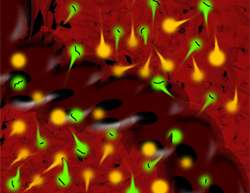Molecular controller switches off genetic material

(Phys.org) -- Genetic material has many inactive sections that are of major importance for cell identity and genome stability. The HP1 protein takes on key functions in shutting down such genomic sequences. In the latest issue of Molecular Cell, in a collaborative effort from the Friedrich Miescher Institute for Biomedical Research (FMI) and the Biozentrum of the University of Basel, researchers show how HP1 functions in repressing the genome at the molecular level.
The genetic material in our cells consists of both active and inactive areas. While the genes in the active areas can be read like an open book, the inactive sections remain under lock and key. These functionally conserved and compacted areas of the genome are important for gene regulation as well as for the stability and correct distribution of chromosomes during cell division. They are specified by biochemical modifications of the genetic material itself or by histones, the proteins around which DNA is wrapped. A protein originally identified in flies as Heterochromatin Protein 1 (HP1) binds particularly modified histones with high specificity and guarantees inactivation of the closed-off areas.
HP1 monitors the inactivation of genetic material
HP1 proteins bind specifically marked histone proteins and shut down the underlying genomic sequences. Using a combination of yeast cell biology and biophysical approaches, Marc Bühler and his team at the FMI together with the structural biologists in Sebastian Hiller's team at the Biozentrum show how this process works at the molecular level. Rather than by just one single HP1 protein, the role of the watchdog is taken by a collective of such proteins, which bind to the histone in a continuous relay. In so doing, HP1 intercepts unwanted RNA transcripts of the repressed genetic material and escorts these molecules to the cellular machinery that degrades them. At that same time, a new HP1 occupies the vacated space on the histone. This continual changeover guarantees that RNA transcripts emanating from supposedly inactive regions of the genome are continuously destroyed.
Dynamic interactions
Biophysical measurements show how HP1 dynamically monitors the chromatin situation. This dynamic cycling allows the cell to control gene deactivation on two different levels at the same time. "Our findings illustrate the importance of HP1 in yeast," comments Claudia Keller, PhD student in Marc Bühler's laboratory. "However, HP1 has persisted throughout evolution and is present in human cells as well. In the future we will be aiming at a better understanding of how the protein functions in man, and will investigate the structure of HP1 in greater detail."
More information: Keller C, et al. (2012). HP1Swi6 mediates the recognition and destruction of heterochromatic RNA transcripts. Molecular Cell, doi:10.1016/j.molcel.2012.05.009
Journal information: Molecular Cell



















